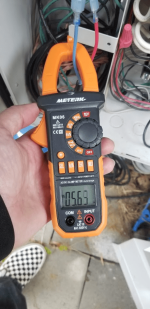Codes 120 and 121 mean low
current (amps) passing through the cell. This often means chlorine is possibly being generated, but not at expected levels.
That can be the result of:
- Something wrong with the current sensing, so there's actually nothing wrong; you're getting a false report. Very unlikely.
- Something wrong with the power supply. It's not delivering enough. Possible but not likely.
- Too much resistance in the power wiring or switching. Bad cord seems to be the most common cause, but also could be any connection carrying cell power (like a plug+socket on the control board) or the relay contacts.
- Too much resistance in the cell itself. Can be
- Calcium or other coating on the plates.
- Low salt.
- Deteriorated internal connections like rotten pins, welds, or wires.
- Deteriorated exotic metal coatings on plates.
Once you've cleaned the cell and verified the salt level, other points under 4 mean cell replacement. Everything else, 1-3, means fix the electronics/power supply.
So you'd really like to determine if 4 is the problem.
This troubleshooting document shows how to do that on slide 23. Check the voltage at the cell with it set to 100%. If
above 28vdc, chances are excellent everything else is fine and the cell is the culprit. A bit of Ohm's Law makes this easy to see.
Low voltage will usually mean 2 (unlikely) or 3 (probably).
"In range" voltage 22-28 along with 120/121 is either 1 or multiple problems: something from 2,3 and also something from 4.
Caveat: I'm not an expert on SWGs, but an EE. The above is basic electrical stuff, not rocket science.



